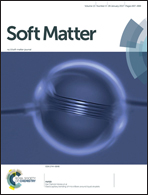Stretching-induced wrinkling in plastic–rubber composites†
Abstract
We examine the mechanics of three-layer composite films composed of an elastomeric layer sandwiched between two thin surface layers of plastic. Upon stretching and releasing such composite films, they develop a highly wrinkled surface texture. The mechanism for this texturing is that during stretching, the plastic layers yield and stretch irreversibly whereas the elastomer stretches reversibly. Thus upon releasing, the plastic layers buckle due to compressive stress imposed by the elastomer. Experiments are conducted using SEPS elastomer and 50 micron thick LLDPE plastic films. Stretching and releasing the composites to 2–5 times their original length induces buckles with wavelength on the order of 200 microns, and the wavelength decreases as the stretching increases. FEM simulations reveal that plastic deformation is involved at all stages during this process: (1) during stretching, the plastic layer yields in tension; (2) during recovery, the plastic layer first yields in-plane in compression and then buckles; (3) post-buckling, plastic hinges are formed at high-curvature regions. Homogeneous wrinkles are predicted only within a finite window of material properties: if the yield stress is too low, the plastic layers yield in-plane, without wrinkling, whereas if the yield stress is too high, non-homogeneous wrinkles are predicted. This approach to realizing highly wrinkled textures offers several advantages, most importantly the fact that high aspect ratio wrinkles (amplitude to wavelength ratios exceeding 0.4) can be realized.



 Please wait while we load your content...
Please wait while we load your content...